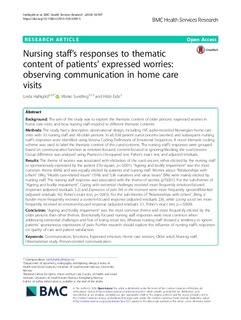| dc.contributor.author | Hafskjold, Linda | |
| dc.contributor.author | Sundling, Vibeke | |
| dc.contributor.author | Eide, Hilde | |
| dc.date.accessioned | 2018-10-05T06:58:27Z | |
| dc.date.available | 2018-10-05T06:58:27Z | |
| dc.date.created | 2018-08-08T11:02:18Z | |
| dc.date.issued | 2018 | |
| dc.identifier.citation | BMC Health Services Research. 2018, 18:597 (1), 1-15. | nb_NO |
| dc.identifier.issn | 1472-6963 | |
| dc.identifier.uri | http://hdl.handle.net/11250/2566546 | |
| dc.description | This article is distributed under the terms of the Creative Commons Attribution 4.0 International License , which permits unrestricted use, distribution, and reproduction in any medium, provided you give appropriate credit to the original author(s) and the source, provide a link to the Creative Commons license, and indicate if changes were made. The Creative Commons Public Domain Dedication waiver applies to the data made available in this article, unless otherwise stated. | nb_NO |
| dc.description.abstract | Background
The aim of the study was to explore the thematic content of older persons’ expressed worries in home care visits, and how nursing staff respond to different thematic contents.
Methods
The study had a descriptive, observational design, including 195 audio-recorded Norwegian home care visits with 33 nursing staff and 48 older persons. In all, 638 patient cues/concerns (worries) and subsequent nursing staff’s responses were identified using Verona Coding Definitions of Emotional Sequences. A novel thematic coding scheme was used to label the thematic content of the cues/concerns. The nursing staff’s responses were grouped based on communicative function as emotion-focused, content-focused or ignoring/blocking the cue/concern. Group difference was analysed using Pearson’s chi-squared test, Fisher’s exact test, and adjusted residuals.
Results
The theme of worries was associated with elicitation of the cue/concern, either elicited by the nursing staff or spontaneously expressed by the patient (Chi-square, p< 0.001). “Ageing and bodily impairment” was the most common theme (66%) and was equally elicited by patients and nursing staff. Worries about “Relationships with others” (9%), “Health care-related issues” (15%) and “Life narratives and value issues” (9%) were mainly elicited by nursing staff. The nursing staff response was associated with the theme of worries (p˂0.001). For the sub-themes of “Ageing and bodily impairment”, Coping with existential challenges received more frequently emotion-focused responses (adjusted residuals: 3.2) and Expression of pain felt in the moment were more frequently ignored/blocked (adjusted residuals: 4.0, Fisher’s exact test, p< 0.001). For the sub-themes of “Relationships with others”, Being a burden more frequently received a content-focused response (adjusted residuals: 2.8), while Losing social ties more frequently received an emotion-focused response (adjusted residuals: 3.1, Fisher’s exact test, p = 0.009).
Conclusion
“Ageing and bodily impairment” was the most common theme and more frequently elicited by the older persons than other themes. Emotionally focused nursing staff responses were most common when addressing existential challenges and fear of losing social ties. Whereas nursing staff showed a tendency to ignore patients’ spontaneous expressions of pain. Further research should explore the influence of nursing staff’s responses on quality of care and patient satisfaction. | nb_NO |
| dc.description.sponsorship | This study was supported by the Research Council of Norway (PraksisVEL, grant no. 226537) and the University College of Southeast Norway, Faculty of Health and Social Sciences, Drammen. The funding sources were not involved in the research or the preparation of the article. The views expressed are of the authors and do not necessarily reflect those of the funding bodies. | nb_NO |
| dc.language.iso | eng | nb_NO |
| dc.publisher | Springer Nature | nb_NO |
| dc.rights | Navngivelse 4.0 Internasjonal | * |
| dc.rights.uri | http://creativecommons.org/licenses/by/4.0/deed.no | * |
| dc.title | Nursing staff’s responses to thematic content of patients’ expressed worries: observing communication in home care visits | nb_NO |
| dc.title.alternative | Nursing staff’s responses to thematic content of patients’ expressed worries: observing communication in home care visits | nb_NO |
| dc.type | Journal article | nb_NO |
| dc.type | Peer reviewed | nb_NO |
| dc.description.version | publishedVersion | nb_NO |
| dc.rights.holder | © The Author(s). 2018. | nb_NO |
| dc.source.pagenumber | 1-15 | nb_NO |
| dc.source.volume | 18:597 | nb_NO |
| dc.source.journal | BMC Health Services Research | nb_NO |
| dc.source.issue | 1 | nb_NO |
| dc.identifier.doi | 10.1186/s12913-018-3390-5 | |
| dc.identifier.cristin | 1600370 | |
| dc.relation.project | Norges forskningsråd: 226537 | nb_NO |
| cristin.unitcode | 222,56,2,0 | |
| cristin.unitcode | 222,56,1,0 | |
| cristin.unitname | Institutt for optometri, radiografi og lysdesign | |
| cristin.unitname | Institutt for sykepleie- og helsevitenskap | |
| cristin.ispublished | true | |
| cristin.fulltext | original | |
| cristin.qualitycode | 2 | |

